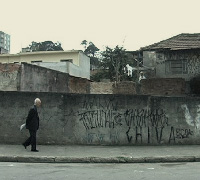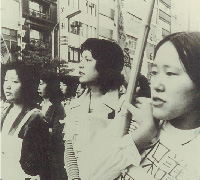ブラジルから来たおじいちゃん
Um Senhor do Brasil Visitando Brasileiros no Japão
A Grandpa from Brazil

ブラジルから来たおじいちゃん公式サイト
A Granpa from Brazil official site in Japanese and Portuguese
http://nanakokurihara.com/senhordobrasil/index.html
予告編へ To Trailer
「しみじみと胸うつ感動!」 サンパウロ新聞
「おじいちゃんのしわの深さ、表情、そして、佇まいがすべてを物語っている。日系人が歩み、乗り越えてきた長い長いストーリーを。」 宮沢和史(ミュージシャン)
「80になっても、90になっても、いきがいを求め、人々を愛し、自分は何者かと考え続ける。『自分が決めたことだから』とブラジルでの苦難を耐え切った人の老いの生きざまは、なお未来を向いてすがすがしい。美しい笑顔と映像から、静かな感動と生きる力を頂いた。」 堀田 力(さわやか財団理事長)
「1世紀を生き抜いてきた老移民がふりかえるみずからの姿。日本に見て聞いて語る在日ブラジル人の姿。そこに海外移住とデカセギの凝縮された生きざまを見る思いがした。ブラジル移住100年にふさわしい珠玉のドキュメンタリーである。」 中牧弘允(国立民族学博物館教授)
This film by Nanako Kurihara focuses on a resourceful and dignified 92-year-old Japanese man who emigrated to Brazil in 1931, raised a large and loving family, and now travels regularly to Japan to help Brazilians who have been brought in as low-paid guest workers in Japan. His reflections on nearly a century of transnational experiences provide a vivid picture of the special challenges that foreign workers face and their creative strategies for solving them.
Laura Hein
Professor of Japanese History, Northwestern University
“Deeply Moving”
Jornal São Paulo Shimbun
解説
紺野堅一さんは、現在92歳。不況まっただ中の戦前の日本から、出稼ぎのつもりで単身ブラジルに渡って72年。言葉もわからない土地で、10回も職業を変え、破産の憂き目にもあった。だが、諦めずに努力した甲斐があって、今ではサンパウロで悠々自適の暮らしをしている。
しかし、紺野さんは家でじっとしているご隠居さんではない。今年も紺野さんは飛行機だけでも26時間かけて日本にやってくる。それは日本に出稼に来ている 若いブラジル人たちを訪ねるためだ。日本在住の日系ブラジル人の数は現在31万人を超え、増加と滞在長期化傾向にある。彼らの姿が、出稼ぎのはずがブラジ ルに定住するはめになった自身の体験と重なる。彼らの将来はいったいどうなるのか。子供たちの教育の現状はどうか。若い世代の仕事の苦労話に耳を傾け、子 供たちに勉強の様子を尋ねる。先生たちと懇談するため学校へも出かけていく。
そして、この旅は彼自身の人生を振り返る旅でもあった。「大日本帝国臣民」として、それともブラジル人として人生を終わるのか。レイルパス片手に新幹線、ローカル線、バスと乗り継ぎ、自分の足で歩きながら考える。
うんと前からグローバルに生き抜いてきたおじいちゃんのくれるアドバイスは? また、旅の末に、彼のたどり着いたアイデンティティとは? 90歳を超えても遠い未来を見すえて、希望を語るおじいちゃんの物語、はじまり、はじまり。
Synopsis
A Grandpa from Brazil focuses on the journey of Mr. Ken’ichi Konno, a ninety-two-year-old Japanese who migrated to Brazil in 1931. In telling Mr. Konno’s story, A Grandpa from Brazil also traces the history of Japanese immigration to Brazil and the current “reverse immigration” from Brazil to Japan.
Mr. Konno traveled alone to Brazil when he was nineteen years old to escape the financial crises of his homeland. During the Great Depression, the Japanese government promoted a policy of dispatching citizens overseas to reduce the pressures of overpopulation. Promised an easier life in Brazil, young Konno saw emigration as his only choice.
Through grit and good luck, he became the patriarch of a large, mixed family. Though he has found peace at the end of his long life, he does not forget that others are still fighting his old battles. In particular, he concerns himself with Brazilians of Japanese descent who have recently made the journey from Brazil to Japan in search of a more prosperous society. 320,000 Japanese-Brazilians have filled job vacancies caused by labor shortages in Japan, far exceeding the 250,000 Japanese who emigrated to Brazil over the last century.
When visiting Japan, Konno listens to these “new” immigrants talk about their problems and offers advice to them, even meeting with local schoolteachers. He also visits landmarks of his youth that inspire him to reflect upon the joys and sorrows of his life.
This timely, passionate tale follows a seemingly ordinary man on his extraordinary journey.
対象となる課目
社会科、グローバリゼーション、多文化共生、国際交流、移民、地球市民、トランスナショナル文化等
Related Subjects
Brazil, Japan, Social Studies, History, Globalization, Diversity, International Exchange, Intercultural Communication, Immigration, Global Citizenship, Transnational Culture
これまでの上映
東京国際女性映画祭、東アジア移住共生映画祭、グローバリゼーションとひとの移動映画祭
北九州ビエンナーレ、ジャパン・ファウンデーション・サンパウロ、ブラジル大使館、関西ブラジル人コミュニティ、群馬県太田市定住外国人子ども支援事業推進協議会、JICA中部、JICA大阪
大阪大学、京都精華大学、シカゴ大学、獨協大学、名古屋大学、名古屋学院大学、ノースウェスタン大学、浜松学院大学、龍谷大学、大阪学院大学、早稲田大学等
Past Screenings
The film had a premiere at the Tokyo International Women’s Film Festival in 2008. It happened to be released in the year of a centennial of Brazilian emigration to Brazil and Lehman shock in which a number of Brazilian workers lost their work and often also home. The film had theatrical runs across Japan and also has been screened at more than seventy locations, especially colleges and a number of communities with large Brazilian population. In the United States, it was shown at Northwestern University and University of Chicago.
will be shown at the Association for Asian Studies Conference March 2012 in Toronto
Tokyo International Women’s Film Festival, Kitakyushu Biennial, East Asian Migration Film Festival, Globalization and Human Migration Film Festival
Kitakyushu Biennial, Japan Foundation São Paulo, Embassy of Brazil Tokyo, Kansai Brazilian Community, Ota City Gunma Prefecture
Osaka University, Nagoya University, Dokkyo University, Nagoya Gakuin University, Kyoto Seika University, Hamamatsu Gakuin University, Ryukoku University, Osaka Gakuin University, Waseda University, JICA Chubu, JICA Osaka and others
DVD購入はこちら For DVD Purchase
上映レンタルはこちら For DVD Rental

監督 栗原奈名子
撮影 栗原奈名子、エリオ・イシイ(サンパウロ)
編集 斉藤貴志、今野裕一郎
整音 小川武
音楽 道下和彦
Director & Producer Nanako Kurihara
Editor: Takashi Saito, Yuichiro Konno
Cinematography: Nanako Kurihara, Helio Ishii (Sâo Paulo)
Sound Design: Takeshi Ogawa
Original Music: Kazuhiko Michishita
2008年 ドキュメンタリー作品/カラー/ミニDV/60分
日本語・ポルトガル語/ポルトガル語・ 日本語字幕
協力 関西ブラジル人コミュニティ、BUSSTRIO、NPO大阪アーツアポリア
後援:駐日ブラジル大使間、日本ブラジル中央協会、IOM(国際移住機関)
2008 / 60 minutes / color / sound / miniDV / NTSC / Japan, Brazil
Japanese, Portuguese / English subtitles





